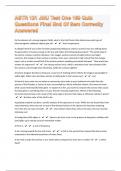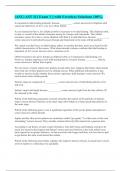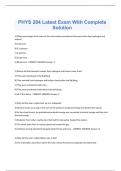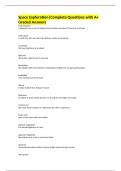Nebula - Study guides, Class notes & Summaries
Looking for the best study guides, study notes and summaries about Nebula? On this page you'll find 335 study documents about Nebula.
Page 4 out of 335 results
Sort by

-
SDSU Ocean 100 Final SacramentoGrilo Exam Questions and Answers Graded A 2024
- Exam (elaborations) • 16 pages • 2024
- Available in package deal
-
- $13.49
- + learn more
origin of earth - • Supernova: death of a star (great explosion) • Supernova happened 4.6 bya, dust and gas flattens to a disk and spins faster due to gravity and solar nebula formed. • Solar Nebula: describes formation of Earth 4.5 bya • Nebula: gas cloud origin of oceans - • volcanic explosion, H2O condensed and rained down for thousands of years to create oceans • icy comets hitting earth (responsible for 1/2 of earths ocean water) origin of life - • 4.5 bya ...

-
Oceanography final exam || with 100% Errorless Answers.
- Exam (elaborations) • 51 pages • 2024
- Available in package deal
-
- $15.99
- + learn more
c correct answers 1. Where did all of the heavy elements that are found inside of your own body (e.g., carbon and nitrogen, phosphorous, copper and gold) get created? a. 50% of the heavy elements were created directly from the Big Bang and the other 50% were created later inside of stars or when stars exploded. b. 10% of the heavy elements were created directly from the Big Bang and about 90% were created later inside of stars or when stars exploded. c. 100% of the heavy elements were c...

-
ASTR 1020 Final Exam Study Guide 2024
- Exam (elaborations) • 18 pages • 2024
-
- $14.49
- + learn more
White dwarfs: properties - Remaining cores of dead, low mass stars Electron degeneracy pressure supports them against gravity Slowly fade with time Sirius and its hot WD companion White dwarfs with same mass as Sun are about same size as Earth; slowly cooling Typical density 10^6 gram / cubic cm Higher mass white dwarfs are smaller Cannot be more massive than 1.4MSun, the Chandrasekhar limit WDs in binaries: nova, supernova Type I - Mass falls toward white dwarf from binary companion ...

-
ASTR 121 JMU Test One 169 Quiz Questions Final End Of Sem Correctly Answered
- Exam (elaborations) • 13 pages • 2024
- Available in package deal
-
- $8.49
- + learn more
(In the absence of a strong magnetic field), what is the chief factor that determines what type of electromagnetic radiation objects give off: - ️️their temperature A college friend of yours who has been postponing taking any science courses hears you talking about the generation of nuclear energy in the Sun and makes the following observation: "The whole idea of the atomic nucleus is pretty ridiculous. If an oxygen nucleus consists of eight protons and eight neutrons, the charge on that n...

-
(ASU) AST 111 Exam 3 || with Errorless Solutions 100%.
- Exam (elaborations) • 9 pages • 2024
- Available in package deal
-
- $11.29
- + learn more
Io experiences tidal heating primarily because __________. correct answers Io's elliptical orbit causes the tidal force on Io to vary as it orbits Jupiter. As you learned in Part A, Io's elliptical orbit is necessary to its tidal heating. This elliptical orbit, in turn, is a result of the orbital resonance among Io, Europa, and Ganymede. This orbital resonance causes Io to have a more elliptical orbit than it would otherwise, because __________. correct answers Io periodically passes Europa...

-
PHYS 284 Latest Exam With Complete Solution
- Exam (elaborations) • 18 pages • 2024
-
- $8.99
- + learn more
PHYS 284 Latest Exam With Complete Solution 1) What percentage of the mass of the solar nebula consisted of elements other than hydrogen and helium? A) 0 percent B) 0.1 percent C) 2 percent D) 20 percent E) 80 percent - CORRECT ANSWER-Answer: C 2) Where did the elements heavier than hydrogen and helium come from? A) They were produced in the Big Bang. B) They evolved from hydrogen and helium shortly after the Big Bang. C) They were produced inside stars. D) They were prod...

-
MEA 200 NCSU|66 Exam Questions And Answers| Success Guaranteed|2024
- Exam (elaborations) • 11 pages • 2024
-
- $7.99
- + learn more
big bang - ️️-still energy left from explosion -discovered in 1960s -assumes earth came from material -Kant created most pop model of formation (planet accretion) nebula - ️️beginning form of planets many bump into others and combine earths composition - ️️-more dense material in center -heterogeneous (bc heat and dense elements melt and flow) -accretion -compression -radioactive decay 3 layers of earth - ️️-based on composition -core, mantle, crust -metallic c...

-
Astronomy 1010 Exam #2 Chapter 12 With Complete & Verified Solutions
- Exam (elaborations) • 12 pages • 2023
-
- $10.49
- + learn more
During the formation of the Solar System, smaller particles in the solar nebula combined to form planetesimals, some of which provided the building blocks for planets. The majority of planetesimals did not become planets, however, and some of them remain in the Solar System today as debris left over from the time of planet formation. Asteroids are a special class of planetesimals that orbit around the Sun. Study the distribution of known asteroids shown in this figure, and choose all of t...

-
Space Exploration|Complete Questions with A+ Graded Answers
- Exam (elaborations) • 8 pages • 2024
-
- $9.89
- + learn more
Space Exploration|Complete Questions with A+ Graded Answers main sequence a diagonal area on an H-R diagram that includes more than 90 percent of all stars white dwarf A small, hot, dim star that is the leftover center of an old star Luminosity the true brightness of an object light year the distance light travels in one year blueshifted the doppler shift toward shorter wavelengths of light from an approaching object Redshifted stars moving away from Earth Ne...

-
Astronomy Final Review UWRF PHYS117 Questions and Answers 100% Solved correctly
- Exam (elaborations) • 12 pages • 2024
- Available in package deal
-
- $7.99
- + learn more
Ursa Major - Answer-circumpolar constellation at 45N Big dipper - Answer-asterism Orion - Answer-asterism Taurus - Answer-zodiac constellation Draco - Answer-circumpolar at 45N Northern Cross - Answer-asterism Your birth sign is - Answer-the constellation behind the sun at the moment of your birth We are currently living in the age of - Answer-Pisces What is the location of of our solar system in the Milk Way galaxy? - Answer-Halfway out from the center How do we know the Milky Way gala...

Did you know that on average a seller on Stuvia earns $82 per month selling study resources? Hmm, hint, hint. Discover all about earning on Stuvia


